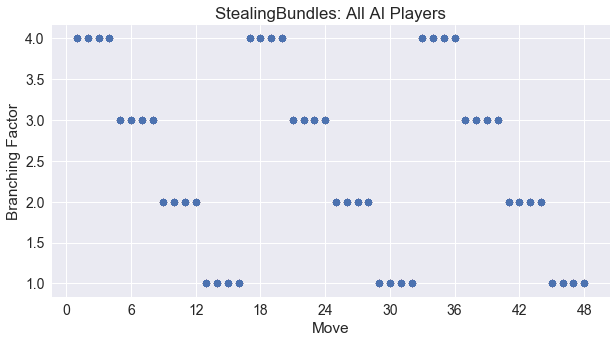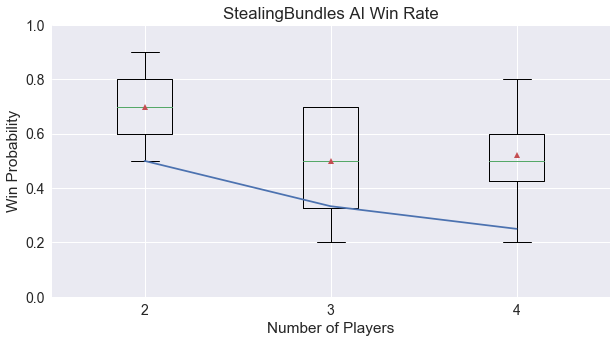
With the basic Stealing Bundles coded in RECYCLE, it is time to run many simulations in CardStock with both random and AI players. As before, to gather statistics for this and the next post on heuristics, we ran 100 games with all random players, 100 games with one AI and the rest random players, and 100 games with all AI players. We did these simulations for 2, 3, and 4 players. Let’s see if we can answer some basic questions about the game.
Are there sufficient choices for players?
Stealing Bundles follows the trick-taking mechanic of “everyone plays one card each round”, but has a different method of distributing the cards. With only four cards being dealt to the players at a time, it feels like you are always in the last few rounds of a trick taking game. We can see the pattern of card choices in the image below showing the choices per player in a four-player game.

Without any restriction to follow suit, each player has the same number of choices each round, and this decreases by one each round. However, in the beginning of the game, players have very little knowledge of the total card landscape, so the results of any decisions are hard to quantify. We’ll see more of how this repeated dealing affects game play when we discuss heuristics in a future post.
How does game length vary with the number of players?
The game length of Stealing Bundles does not depend on the number of players,
as it will always take the same number of turns, namely 48, one for each card not dealt to
the POOL at the start of the game. So, players will have fewer turns per game when
there are more players, making the two-player game feel longer than the four-player game.
Can players be strategic in Stealing Bundles?
With the fog of knowledge created by having the cards dealt out piecemeal, are players able to make strategic choices? The image below shows the win rates of AI players versus random players averaged across the 2, 3, and 4-player games simulated.

In comparison with the expected random win rate, shown by the blue line, AI players can perform admirably, winning greater than 50%. This rate is much lower than Pairs and Ninety-Eight, looking more like the results we found in Agram. A player’s ability to win in Stealing Bundles is dependent on the cards they are dealt, such that even optimal choices by the player can result in a loss.
Up Next
Next post, we’ll see how Stealing Bundles measures up with our heuristics and look at the overall gameplay experience with all AI players. What else would you like to see analyzed about Stealing Bundles? Let me know in the comments below, and I’ll see if I can incorporate them in future posts. Thanks for reading!
comments powered by Disqus

